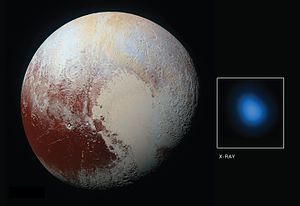Atmosphere
Pluto has a tenuous atmosphere consisting of nitrogen (N2), methane (CH4), and carbon monoxide (CO), which are in equilibrium with their ices on Pluto's surface. According to the measurements by New Horizons, the surface pressure is about 1 Pa (10 μbar), roughly one million to 100,000 times less than Earth's atmospheric pressure. It was initially thought that, as Pluto moves away from the Sun, its atmosphere should gradually freeze onto the surface; however, studies of New Horizons data and ground-based occultations show that Pluto's atmospheric density actually increases, and that it likely remains gaseous throughout Pluto's orbit.

A near-true-color image of Pluto taken by NASA's New Horizons probe after its flyby. The photo shows blue haze layers in Pluto's atmosphere.
New Horizons observations showed that atmospheric escape of nitrogen to be 10,000 times less than expected. Alan Stern has contended that even a small increase in Pluto's surface temperature can lead to exponential increases in Pluto's atmospheric density; from 18 hPa to as much as 280 hPa (three times that of Mars to a quarter that of the Earth).
At such densities, nitrogen could flow across the surface as liquid. Just like sweat cools the body as it evaporates from the skin, the sublimation of Pluto's atmosphere cools its surface. The presence of atmospheric gases was traced up to 1670 km high, although the atmosphere does not have a sharp upper boundary.
The presence of methane, a powerful greenhouse gas, in Pluto's atmosphere creates a temperature inversion, with the average temperature of its atmosphere tens of degrees warmer than its surface, though observations by New Horizons have revealed Pluto's upper atmosphere to be far colder than expected (70 K, as opposed to about 100 K). Pluto's atmosphere is divided into roughly 20 regularly spaced haze layers up to 150 km high, thought to be the result of pressure waves created by airflow across Pluto's mountains.
